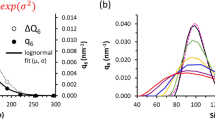Abstract
In this paper we construct and analyze a model of cell receptor aggregation. Experiments have shown that receptors in an aggregated state have greatly reduced mobility. We model the effects of this reduced mobility with a density dependent diffusion and study the impact of density dependent diffusion on aggregate formation in a one-dimensional domain. Critical values of receptor diffusivity and receptor activation are found and compared with numerical simulations. We find that the role of density dependant diffusion is quite limited in the formation of aggregate structures. In the case of receptor activation, the analytical results agree very well with the numerical calculations. Finally, we consider our model in higher dimensional domains. In this case our analysis is primarily numerical.

















Similar content being viewed by others
References
Allen SM, Cahn JW (1979) A microscopic theory for antiphase boundary motion and its application to antiphase domain coarsening. Acta Metall 27(6):1085–1095
Bray D, Levin MD, Morton-Firth CJ (1998) Receptor clustering as a cellular mechanism to control sensitivity. Nature 393(6680):85–88
Bray D, Duke T (2004) Conformational spread: the propagation of allosteric states in large multiprotein complexes. Annu Rev Biophys Biomol Struct 33:53–73
Caré BR, Soula HA (2011) Impact of receptor clustering on ligand binding. BMC Syst Biol 5(1):48
Chan C, George AJT, Stark J (2001) Cooperative enhancement of specificity in a lattice of t cell receptors. Proc Nat Acad Sci 98(10):5758–5763
Changeux J-P, Thiéry J, Tung Y, Kittel C (1967) On the cooperativity of biological membranes. Proc Natl Acad Sci USA 57(2):335
Duke T, Bray D (1999) Heightened sensitivity of a lattice of membrane receptors. Proc Nat Acad Sci 96(18):10104–10108
Duke T, Graham I (2009) Equilibrium mechanisms of receptor clustering. Prog Biophys Mol Biol 100(1):18–24
Heldin C-H (1995) Dimerization of cell surface receptors in signal transduction. Cell 80(2):213–223
Holowka D, Baird B (1996) Antigen-mediated ige receptor aggregation and signaling: a window on cell surface structure and dynamics. Ann Rev Biophys Biomol Struct 25(1):79–112
Jilkine A, Angenent SB, Wu LF, Altschuler SJ (2011) A density-dependent switch drives stochastic clustering and polarization of signaling molecules. PLoS Comput Biol 7(11):e1002271
Kent Ute M, Mao S-Y, Wofsy C, Goldstein B, Ross S, Metzger H (1994) Dynamics of signal transduction after aggregation of cell-surface receptors: studies on the type i receptor for ige. Proc Nat Acad Sci 91(8):3087–3091
Kolokolnikov T, Erneux T, Wei J (2006) Mesa-type patterns in the one-dimensional brusselator and their stability. Phys D 214(1):63–77
Kolokolnikov T, Tlidi M (2007) Spot deformation and replication in the two-dimensional belousov–zhabotinski reaction in a water-in-oil microemulsion. Phys Rev Lett 98(18):188303
Levy C (2015) Modelling the spatial effects of the signal transduction process. PhD thesis, Dalhousie University
Macken CA, Perelson AS (1982) Aggregation of cell surface receptors by multivalent ligands. J Math Biol 14(3):365–370
Maplesoft A division of Waterloo Maple Inc., Waterloo, Ontario. Maple 16
McCloskey MA, Poo M (1986) Contact-induced redistribution of specific membrane components: local accumulation and development of adhesion. J Cell Biol 102(6):2185–2196
McKay R, Kolokolnikov T (2012) Stability transitions and dynamics of mesa patterns near the shadow limit of reaction-diffusion systems in one space dimension. Discret Contin Dyn Syst B 17(1):191–220
Muir P, Pew J (2013) Bacoli95. Fortran95 code
Nishiura Y, Fujii H (1987) Stability of singularly perturbed solutions to systems of reaction-diffusion equations. SIAM J Math Anal 18(6):1726–1770
PDE FlexPDE. Solutions inc. http://www.pdesolutions.com
Sulzer B, Perelson AS (1996) Equilibrium binding of multivalent ligands to cells: effects of cell and receptor density. Math Biosci 135(2):147–185
Thomas JL, Holowka D, Baird B, Webb WW (1994) Large-scale co-aggregation of fluorescent lipid probes with cell surface proteins. J Cell Biol 125(4):795–802
Wanant S, Quon MJ (2000) Insulin receptor binding kinetics: modeling and simulation studies. J Theor Biol 205(3):355–364
Wei J, Winter M (2009) Spikes for the Gierer–Meinhardt system with discontinuous diffusion coefficients. J Nonlinear Sci 19(3):301–339
Author information
Authors and Affiliations
Corresponding author
Rights and permissions
About this article
Cite this article
Iron, D., Rumsey, J. A model of cell surface receptor aggregation. J. Math. Biol. 75, 705–731 (2017). https://doi.org/10.1007/s00285-017-1094-9
Received:
Revised:
Published:
Issue Date:
DOI: https://doi.org/10.1007/s00285-017-1094-9




